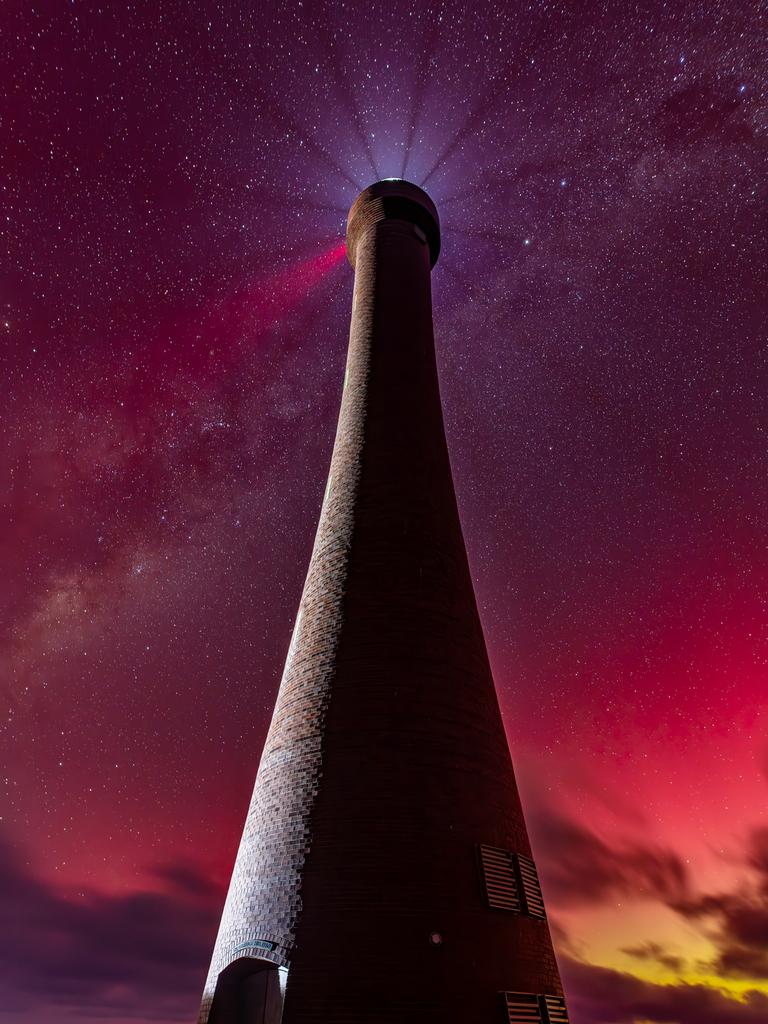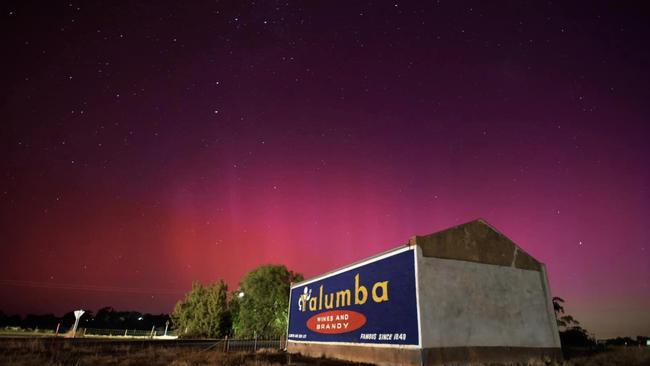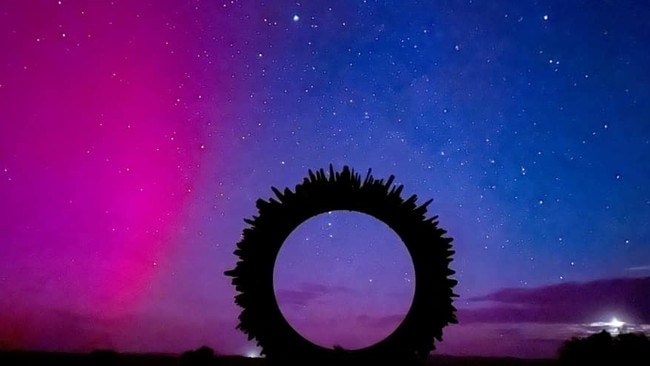Aurora Australis coming to an end as light show lingers for third straight night
Did you miss the spectacular Aurora Australis light show? See the pictures instead, with 80+ readers photos.
SA News
Don't miss out on the headlines from SA News. Followed categories will be added to My News.
The dazzling Aurora Australis has lit up South Australian skies with stunning colours in a rare phenomenon not seen in more than 20 years.
South Australians have taken to vantage points with dark skies to capture the incredible show, with viewing points from Glenelg to Kangaroo Island, Yorke Peninsula to Adelaide’s fringes.
Between 10pm and 2am Saturday was billed at the best viewing time as the impacts of the biggest geomagnetic storm since 2003 became visible.
Amateur photographer Adam Meyer captured the lights over Troubridge Hill Lighthouse, west of Edithburgh on the Yorke Peninsula about 10pm Saturday.
“It blows you away when you can see light and colour with the naked eye,” he said.
Having photographed the Aurora Australis once before, in February last year, he knew to face south in a cloudless and clear sky.
But he had never seen it anywhere “near as bright or as clear” as Saturday’s spectacle, likening it to an insofar once in a lifetime shot.
He used a Canon 5DSR with a 20 second exposure, with one frame backlit by a passing car, but said similar stunning images were captured on smart phones.
“When you see the images from as far as the Pilbara and Uluru then it gives you an idea of the magnitude of it, and the best conditions for decades,” he said.
“I think it’s really good to see people going out and capturing the beauty of nature around us.”

Astronomer and UniSA astronomy lecturer Mary Adam said the sun went through a cycle every 11 years, resulting in either a solar minimums or a solar maximums, the latter of which has delivered the Southern Lights.
“There’s a region of sun spots that have become visible on the sun and it’s from that cluster of sun spots what we call an X1 flare,” Ms Adam said.
“With solar storms, they get thrown off the sun and out into space so it is a mass of charged particles.”
Ms Adam said it was common to see red and green lights in the Aurora Australis but the purple hues – visible to the naked eye – were because of the G5 solar storm, the largest since 2003.
“The red and the green are charged particles reacting with the oxygen in our atmosphere, but the purple is when it’s reacting with the nitrogen,” she said.
“It’s the solar wind reacting with the gases in our atmosphere.”
She said G5 events usually lasted a day, but the “extreme solar storm” meant the lights were visible for three nights, with the last chance on Sunday evening.
But it was impossible to predict when the next could occur given the unpredictability of the sun.
The most intense geomagnetic storm, known as the Carrington Event, was recorded in 1859 that created strong auroral displays seen across the globe.
Ms Adam said that event knocked out power grids, and storms the size of a G5 could wreak havoc on satellite-dependent technologies.
But because the charged particles do not travel at the speed of light, there was generally a couple of days’ advance notice of solar flare activity.
And what made the weekend’s light spectacle so incredible, she said, was the lack of cloud cover.

“It has been 20 years since we have seen something of this magnitude,” she said.
“It’s piquing people’s interest in getting out and looking up at the sky.”
She said she hoped it would draw attention to light pollution.
The Bureau of Meteorology predicted patchy cloud cover over South Australia on Sunday night, giving a last chance to see the Southern Lights.
Meteorologist Jenny Horvat on Sunday afternoon said there was an approaching front that could deliver some cloud cover.
“But it is patchy and there’s gaps in it, so it will be a bit hit and miss,” she said.
“You have got a bit of a chance but probably not as good as we saw (Saturday) night.”
The cover was seen over western Kangaroo Island and into the south east.
The best times to view are when it is dark and looking toward the south, away from the direction of the sun’s travel.
Times can range from 10pm to 2am.
The storm was created by a monster sunspot cluster 16 times the size of Earth, which has been spewing solar eruptions in the Earth’s direction.
The Bureau of Meteorology’s Australian Space Weather Forecasting Centre, located in Adelaide, issued a warning indicating the chance of G5 (extreme) geomagnetic storm conditions on Saturday.
The centre’s updated geomagnetic warning on Sunday said further coronal mass ejection arrivals were “anticipated” including for Monday.
They were expected to “induce planetary G3 conditions” on Sunday, and G1-G2 conditions on Monday.
Geomagnetic conditions were expected to decline by Tuesday.
Geomagnetic storms of G5 level have the potential to disrupt critical infrastructure such as power grids, but SA Power Networks reported no outages as a result of the phenomenon.
Globally there were no significant impacts reported from the storm, however SpaceX’s Starlink satellite internet services reported its service had been degraded and a team was investigating the cause.
The National Oceanic and Atmospheric Administration’s Space Weather Prediction Center issued a global G4 Geometric Storm Watch for the first time since 2005.
“This is an unusual and potentially historic event,” said Clinton Wallace, NOAA’s Space Weather Prediction Center director.
An aurora is a natural light display that glimmers in the sky within the thermosphere – one of Earth’s upper atmosphere layers.





